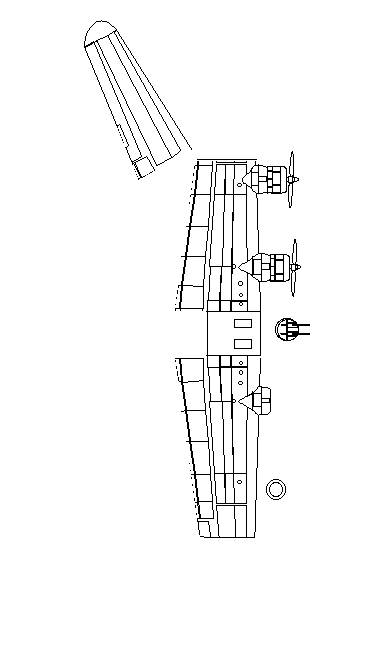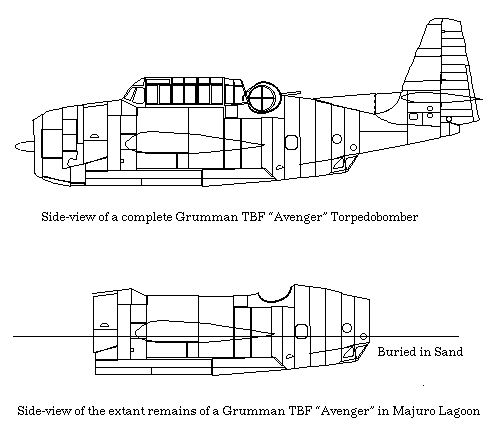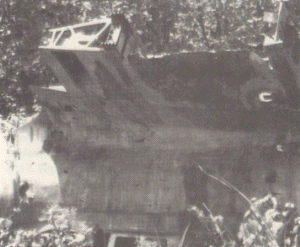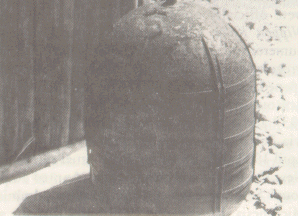

|
Essays on the Marshallese Past
Aviation Archaeology in the Marshall Islands |
Aviation has played an important role, both good and bad, in the social and economic development of countries of the Pacific Ocean area: air services have made it possible to cover in a short time the vast distances separating countries, as well as the distances separating islands within the countries.
For centuries the vast distances of the Pacific made inter-island and inter-atoll communication a matter of long distance voyages and navigational skills. The large Marshallese voyaging canoes, such as the
Traditionally it was not feasible to go from
This increased mobility has brought about some cultural changes, and a greater uniformity among the Marshallese population. Talking to old people one often hears the assertion that the people of
During the end of last century there was a well developed dialect of the
Last century the communication patterns ran from the more densely populated southern atolls to the northern atolls, each chain keeping to themselves, with very little inter-chain communications. Only in the populated south there were communication links, between
Last century there was no national identity, but a conglomeration of individual atolls, some of which were interconnected by political alliances or controls.
It is therefore fitting that we have a good look at some aspects of the history of aviation and the physical reminders of this history. It is now over fifty years ago that civilian aviation began in the
Crashed airplanes are the most common historical resources. They are archaeological artifacts, and as such have only limited interpretative value. Archaeological research can provide many data on the crash, as well as the subsequent fate of the plane. But it remains largely descriptive, by the nature of the data, and detached from the human tragedy which may have led to or resulted from the plane crash. However, if research can penetrate beyond the description of the plane wreckage as such, if the particular plane can be identified; if the circumstances of the crash can be elucidated; if the historical research allows the crew to emerge as individuals from the mist of time; then the interpretation of the aircraft reaches other dimensions.
Aviation Archaeology
Aviation archaeology as a sub discipline of archaeology is in its infancy worldwide. Less than a hundred years ago the first powered heavier-than-air flight occurred. The field addresses both the archaeology of single airplane wrecks and the archaeology of the support structures of aviation, such as airfields and related structures (air operations centers, flight controls etc.). Research issues focus on the archaeological site formation process of aircraft wrecks and patterns therein; on the study of modern mass transportation systems, and their social and political impacts; as well as on the interpretative uses of such sites for educational and recreational purposes.
Historical resources deriving from aviation often pose cultural resource management problems similar to those of shipwrecks: ownership, actual and moral; preservation; interpretation. Often the aircraft wrecks have little in common with the country they rest in, belong to the heritage of other cultures, and brought into the local orbit only by happenstance.
The fighting of World War II in the
There are four major categories of resources related to aviation:
The following kinds of sites related to aviation existed in the
The second category are the planes themselves: The Japanese and American military aircraft known or strongly suspected to be present in the historical record of the World War II sites in the Republic of the
In addition, civilian aviation before the war brought other aircraft to the atolls of the
The Japanese civilian airline Dai Nippon operated the Kawanishi H6K flying boat, which saw as the "Mavis" extensive service in the Pacific War (see below).
Airfields
As in many other Pacific Island nations many modern airfields go back to the times of World War II. In the Marshall Islands the presently used runways of Wotje, Taroa and Mile are all former Japanese bomber or fighter strips. So is the runway on
After the landing of the U.S. forces on Majuro on January 31st, 1944, the "Seabees" commenced preparations and finally construction of a bomber strip on Delap Island. The U.S. forces also developed a small seaplane base next to the airfield on Delap Island. A seaplane ramp was installed and several moorings laid.
In addition, the Japanese had begun the development of a seaplane base on
TABLE 1: JAPANESE AND AMERICAN MILITARY AIRCRAFT KNOWN OR STRONGLY SUSPECTED TO BE PRESENT IN THE HISTORICAL RECORD OF THE WORLD WAR II SITES IN THE REPUBLIC OF THE MARSHALL ISLANDS. THOSE TYPES OF WHICH AIRCRAFT WRECKS ARE KNOWN ARE SHOWN IN ITALICS.
| JAPANESE AIRCRAFT | AMERICAN AIRCRAFT |
|---|---|
| Aichi D3A1 Type 99 ("Val") | Bell P-39 "Aircobra" |
| Aichi E13A ("Jake") | Consolidated B-24 "Liberator" |
| Kawanishi H6K ("Mavis") | Consolidated PB2Y "Coronado" |
| Kawanishi H8K ("Emily") | Consolidated PB5Y "Catalina" |
| Mitsubishi A5M ("Claude") | Curtiss C-46 "Skytrain" |
| Mitsubishi A6M2 ("Zero") | Curtiss P-40 |
| Mitsubishi A6M2-N ("Rufe") | Curtiss SB2-C "Helldiver" |
| Mitsubishi A6M3 ("Hamp") | Douglas C-47 "Dakota" |
| Mitsubishi F1M ("Pete") | Douglas C-54 "Skymaster" |
| Mitsubishi G3M Type 96 ("Nell") | Douglas SBD-3/A-24 "Dauntless" |
| Mitsubishi G4M Type 1 ("Betty") | Grumman "Duck" |
| Mitsubishi Ki-21 Type 97 ("Sally") | Grumman F4F "Hellcat" |
| Nakajima B5N ("Kate") | Grumman TDB/TBF "Avenger" |
| Nakajima B6N Tenzan ("Jill") | Martin PBM "Mariner" |
| Nakajima G5N "Shinzan" | North American B-25 "Mitchell" |
| Nakajima G5N1 ("Liz") | Vought F4U "Corsair" |
| Yokosuka D4Y ("Judy") | Vought OS2U "Kingfisher" |
|
|
IN ADDITION, SOME AIRCRAFT ARE KNOWN TO HAVE BEEN USED OR FERRIED THROUGH THE MARSHALL ISLANDS, BUT NO REPORTS OF CRASHES OR LOSSES HAVE BEEN
REPORTED. AMONG THESE AIRCRAFT ARE: BOEING B-17 "FLYING FORTRESS
"; CONVAIR B-32 "DOMINATOR"; AND THE BOEING B-29
"SUPERFORTRESS."
Plane wrecks
A number of plane wrecks has been documented in the R.M.I. to date. For some of the wrecks we have historic documentation, while for many others we do not. What follows is a summary of the resources recorded. Most of the planes have been documented in greater detail and reports have been drawn up.
Consolidated B-24 J off
The wreckage of a Consolidated B-24J "Liberator" # 42-73013 bomber rests on the reef platform between
Consolidated B-24D on
The wreckage of a B-24D "Liberator", a Consolidated San Diego-built B-24D, block 145 (B-24D-145-CO), Serial number #42-41205) (nickname "St. Quentin Quail") rests on the lagoonside of
Two of the crew members died in the crash and were buried on Arno. Eight of the crew members survived the crash and were housed and fed by the natives on Arno Atoll from January 3 to January 16, 1944, on which date a Japanese patrol boat arrived from

Plan view of the Consolidated B-24 D "Liberator" bomber resting at a beachrock spur on the lagoon side of
The perished crew comprised of:
The plane wreck rests in the intertidal zone off a beachrock spur off Jab'u Island in 1 to 1.5m of water at low tide, some 30-40m from the present high-tide mark. Extant are the port wing, a large part of the starboard wing, the central fuselage section between the wings, and all four engines. Only one propeller was seen, although the others may well rest buried in the sand. The tip section of the port wing from the port No.2 engine onwards is snapped off and twisted backwards. The bottom of the lagoon shows a few isolated pieces of aluminium, among them the ring of the central Martin turret. No pieces of the pilots cockpit or the entire rear fuselage including rear ailerons could be located.
The aluminium is on the whole in good condition and it can be expected that as long as no untoward actions happen, the plane will be around for some time. The plane, resting on the reef has been utilised by the Arno people in the 1940s and 1950s as a resource for aluminium to manufacture coconut-grater blades, husking-stick points and other artifacts for daily use.
Grumman TBF "Avenger" in
The remains of a Grumman TBF "Avenger" torpedo bomber rest in two locations: on the oceanside reef platform of
On the ocean shore, in the intertidal zone rests the engine block, while parts of the cylinder heads, as well as parts of manifolds can be found in the shrub of the island. At one point all three propeller blades have been removed; two of them could be pulled off, while the third one was sawn off.
The main part of the plane seems to have been washed down a sediment fan between the islands of Bok-allep and Lijeboro. Extant are the wings, parts of the engine mounting and parts of the fuselage, extending behind the tail gunners position. The cock-pit is stripped of all armature and the rear machine gun has been removed at one point in time, most likely before the plane became submerged. The port wing of the plane is at about 140 feet, while the starboard wing is at about 120 feet.

Side view of a Grumman TBF "Avenger" aircraft (top) and view of the parts surviving at the bottom of
The plane is partially covered with smooth sand from the sediment fan. Depending on current conditions the sand coverage seems to be more or less extensive. Some divers attempting to find the plane have failed to so despite good instructions. It is possible that most parts of the wings, which are by far the visually most distinctive part of the wreckage from a greater distance have been completely covered up with sand. Parts of the fuselage, as well as parts of the tail section can be found higher up on the slope, indicating that the plane partially broke up as it slid down the sediment fan.
Kawanishi H8K Flying boat off Wotje I
.
The wreckage of a Kawanishi H8K "Emily" flying boat rests some 100 metres off the Japanese seaplane ramp on Wotje. It is likely that the aircraft belonged to the 801st or 802nd Kokutai stationed on Wotje and Jaluit. The aircraft appears to have been sunk at its moorings when it received a direct hit at the intersection of the wings and the fuselage. The wreckage is well confined in its horizontal spread and rests in 20 to 30 feet of water. Due to the lack of SCUBA gear the plane could only be inspected while snorkelling on the surface.
The plane rests in a proper position on the lagoonal bottom, with the nose oriented approximately south-southeast. The preservation of the plane varies. Best preserved is the tail with the tail fin, port and starboard aileron. the wings appear to be complete, but the port wing seems to be bent aft. The central fuselage section between the wings is a scatter of artifacts, where, from the surface, little detail can be made out. The engines seem to be present and identifiable. Most of the nose section has been squashed and cannot be identified with accuracy. It is possible that the plane broke apart just forward of the wings. The dorsal top turret, or the starboard turret rests on the starboard side of the plane. It could not be made out whether the machine gun is still in the turret.
The aluminium seems to be in good shape, though partially overgrown by coral and other marine growth. The surfaces of the tail fin rudder, as well as the trim flaps of the tail assembly are gone. The same holds true for the flaps on the wings. It would appear that these were made of organic material, possibly covered with canvas.
The preservation of the plane makes it likely that it was surprised by U.S. aircraft and sunk at its mooring, most probably by a direct hit either between the wings of just forward of the wings, as there the destruction is the greatest.
Aichi D3A "Val" Dive bomber on Mile I.
Next to the hangars on Mile rests the cannibalised wreckage of an Aichi D3A "Val" dive bomber, which most likely once belonged to the 552nd Kokutai stationed on Mile from mid-1943 to October or November 1943.
The plane rests on its back, tilted on the remains of the starboard wing. The plane remains present comprise the main fuselage from the engine firewall to the tail. The wings have been disassembled and the tips have been removed to a location west of the hangar. Missing from the plane are the tail fin and rudder, the fixed landing gear as well as engine, engine cowlings and the propeller. In addition the plane seems to have been stripped of everything useful including all instrumentation and armament.
The wreckage makes a very orderly appearance and as such is very different from most other wrecks seen on Mile or Taroa. The plane appears as if it had been dismembered systematically ("Cannibalized") and the neat storage of the wings attests to this. There are no lose cables and pieces of wiring visible, the wreck having appearance of having been "picked clean".

Wreckage of an Aichi D3A "Val" divebomber on Mile.
Aichi D3A "Val" bomber at Laura, Majuro
The very much reduced wreckage of an Aichi D3A "Val" dive bomber can be found on the lagoonal shore of
Aircraft in Kwajalein lagoon
As a result of the fierce fighting on
Aircraft in Bikini lagoon
As part of "Operation Crossroads", the nuclear testing programme designed to study the effects of nuclear devices on ships and fleets, a number of vessels were set up as target vessels for the tests "Able" and "Baker". Among the fully equipped ships targeted was the U.S.S. Saratoga (CV-3) with a complement of aircraft, namely three Curtiss SB2C-4 "Helldivers" and one Grumman TBM "Avenger". They are accessible in the hangar deck at depths exceeding 120 feet.
Other
Other aircraft are known. There is of course the abundance of plane wrecks on Taroa and Mile Islands, but also the wreckage of a Grumman "Duck" and of a Martin PBM "Mariner" in Majuro Lagoon and that of a Mitsubishi A6M "Zero" off Jan in
Post-World War II aircraft are the wreckage of a Douglas DC-3, formerly operated by Western Pacific sitting at Majuro Airport and the fuselage of a DeHavilland TwinOtter located at Marina 7, on
Aviation Artifacts
The third category of resources are individual aviation artifacts found on the atolls by chance or intent, and used in ways other then originally intended.
Drop tanks
A common artifacts in adaptive re-use are post World War II aluminium aircraft drop tanks, originally belonging to a North American F-86 "Sabre" jet aircraft, which saw extensive service in the Pacific Area until the late 1950s. These drop tanks, like all others of its type seen on various atolls in the Marshall Islands, was used as a water catchment:
Oxygen Cylinders
Aluminum oxygen cylinders from B-24 aircraft
, cut length wise or across to serve as a cooking pot. This has been seen on
Propeller Blades
A propeller blades has been used as reflectors to guide the way at night through a lagoonal pass at Laura, Majuro Atoll.
Pierced Steel Planks ("Marston Matting")
The use of Marston matting as fence material is very widespread in the
Aircraft Fuselage
Plane wrecks were quickly stripped of their aluminium sheeting, mainly for the use as coconut-grinder blades, husking-stick points and other artifacts.

Oxygen cylinder of a B-24 used as cooking pot (
| select from the following... | ||||||
| |
||||||
|
Digital Micronesia-An
Electronic
Library & Archive
is provided free of charge
as an advertising-free
information service
for the world community. It is being maintained by Dirk
HR Spennemann, Associate
Professor in Cultural
Heritage Management, Institute of Land, Water and Society and School
of Environmental & Information Sciences, Charles
Sturt University,
Albury, Australia. The server
space and technical support are provided by Charles
Sturt University as part of its commitment
to regional engagement. Environmental
SciencesInformation
Sciences
|
||||||